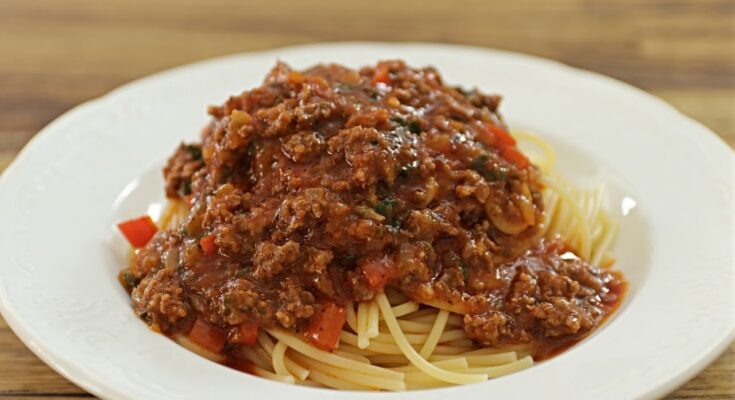Spaghetti and Meat Sauce Recipe: Let’s be honest—some meals never go out of style. And spaghetti with meat sauce? It’s the Michael Jordan of comfort food. Whether you’re whipping it up for a cozy weeknight dinner, serving it at a family gathering, or just satisfying a serious pasta craving, this dish hits all the right notes. It’s hearty, filling, flavorful, and oh-so-satisfying. The sauce is rich, the noodles are perfectly tender, and when it’s all combined? Pure magic.
There’s also something inherently nostalgic about spaghetti and meat sauce. Maybe it takes you back to Sunday dinners with family or a lazy night in with a big bowl of carbs and your favorite show. The beauty lies in its simplicity. You don’t need to be a professional chef or own a Michelin-starred kitchen. If you’ve got a pot, a pan, and about 45 minutes, you’re golden.
Another reason this dish is a go-to? It’s incredibly versatile. You can make it with ground beef, turkey, sausage, or go meatless if you’re leaning plant-based. You can load it up with veggies, spice it up, or keep it classic. No matter how you tweak it, spaghetti and meat sauce always delivers.
The Origins of Spaghetti and Meat Sauce
Before we dive into the recipe, let’s give a quick nod to its roots. While spaghetti originated in Italy, the meat sauce version we know and love today is a more Americanized adaptation of the Italian ragù. In Italy, you’ll find regional versions like Ragù alla Bolognese, a slow-simmered sauce from Bologna typically served with tagliatelle, not spaghetti.
So, technically speaking, traditional Italian chefs might raise an eyebrow at spaghetti being paired with a meaty tomato sauce. But hey, food evolves! This dish gained massive popularity in the U.S. thanks to Italian immigrants who adapted their recipes using locally available ingredients. Over time, the dish became a staple in American households, and today it’s one of the most beloved pasta meals worldwide.
List of Ingredients You’ll Need
Main Ingredients for the Meat Sauce
Here’s what you’ll need to create a rich, flavorful meat sauce from scratch. These ingredients are easy to find, and you might already have most of them in your pantry or fridge:
- Ground Beef (1 lb) – 80/20 blend is best for flavor and fat balance.
- Yellow Onion (1, chopped) – Adds sweetness and depth.
- Garlic (3–4 cloves, minced) – Brings that irresistible aroma and bite.
- Crushed Tomatoes (1 can, 28 oz) – Forms the sauce’s base.
- Tomato Paste (2 tablespoons) – Intensifies the tomato flavor.
- Beef Broth or Water (½ cup) – Helps the sauce reach the right consistency.
- Olive Oil (2 tablespoons) – For sautéing the aromatics.
- Salt and Pepper (to taste) – Essential for seasoning.
- Dried Oregano (1 tsp) – Adds a warm, earthy note.
- Basil (fresh or dried, 1 tsp) – For classic Italian herb flavor.
- Red Pepper Flakes (optional, ½ tsp) – Adds a gentle kick.
This mix strikes the perfect balance of flavor and richness. You can adjust spice levels and salt based on your preference, but don’t skip the herbs—they’re the secret to bringing it all together.
Spaghetti and Optional Add-ons
Of course, the sauce needs a partner—and that’s where the pasta comes in.
- Spaghetti (1 lb) – Regular or whole wheat, cooked al dente.
- Parmesan Cheese (freshly grated) – For topping.
- Fresh Basil or Parsley (for garnish) – Adds freshness and color.
- Butter (1 tablespoon, optional) – Stirred into the sauce for extra richness.
Optional additions that elevate the dish:
- Mushrooms (sliced) – Adds a meaty texture and umami.
- Carrots and Celery (finely chopped) – For sweetness and body.
- Bay Leaf (1) – Drop it in while simmering, then remove.
Pantry Staples You Might Already Have
Don’t underestimate the power of everyday staples when building flavor. These are likely sitting in your kitchen right now:
- Sugar (a pinch) – Balances the acidity of tomatoes.
- Italian Seasoning – A quick blend of oregano, basil, thyme, and rosemary.
- Black Pepper – Freshly cracked if possible.
- Kosher Salt – For seasoning pasta water and sauce.
Keeping these basics stocked ensures you can throw together a delicious spaghetti dinner on the fly—even when you think there’s “nothing” to cook.
Kitchen Tools and Equipment
Essential Utensils for Preparation
Cooking a perfect spaghetti and meat sauce doesn’t require fancy gear, but having the right tools makes everything easier and more enjoyable. Here’s what you’ll want on hand:
- Chef’s Knife & Cutting Board – For chopping onion, garlic, and herbs.
- Wooden Spoon or Silicone Spatula – Ideal for stirring and scraping up flavor bits from the bottom of your pan.
- Measuring Cups and Spoons – Especially useful for spices, tomato paste, and broth.
- Large Skillet or Dutch Oven – The meat sauce needs room to simmer and develop flavor.
Must-Have Cooking Equipment
Let’s not forget the star player—your spaghetti pot.
- Large Pot for Boiling Pasta – Needs to be big enough to give the noodles space to cook evenly.
- Colander – For draining your pasta without making a mess.
- Ladle or Tongs – Useful for transferring spaghetti into the sauce without losing that precious pasta water.
Optional but helpful:
- Garlic Press – Speeds up mincing if you’re not a fan of chopping.
- Grater for Cheese – Freshly grated Parmesan tastes better and melts beautifully.
Step-by-Step Guide to Make Spaghetti and Meat Sauce
Step 1: Prepare Your Ingredients
Before cooking, gather everything you’ll need: 1 pound of ground beef or Italian sausage, 1 onion (chopped), 3 cloves of garlic (minced), 1 can (28 oz) crushed tomatoes, 2 tablespoons tomato paste, 1 teaspoon Italian seasoning, salt, pepper, and olive oil. For garnish, have fresh basil or parsley and grated Parmesan cheese on hand. Also, set aside 1 pound of dried spaghetti for later. Having everything prepped keeps the process smooth and stress-free.
Step 2: Sauté the Aromatics
In a large skillet or saucepan, heat 2 tablespoons of olive oil over medium heat. Add the chopped onion and cook until soft and translucent, about 3–4 minutes. Then, add the minced garlic and cook for another 30 seconds — just until fragrant. This creates the flavorful base that gives your sauce that homemade Italian warmth.
Step 3: Brown the Ground Meat
Add the ground beef (or sausage) to the pan and break it apart with a spatula. Cook for 6–8 minutes, stirring occasionally, until browned and no longer pink. Drain off any excess fat if needed. Season lightly with salt and pepper to enhance the meat’s natural flavor. The browned bits at the bottom of the pan add incredible depth to your sauce.
Step 4: Add Tomato Base and Simmer
Stir in the crushed tomatoes, tomato paste, Italian seasoning, and ½ teaspoon of sugar (to balance the acidity). Add a splash of water or broth if the sauce is too thick. Bring it to a gentle boil, then reduce the heat to low and let it simmer for 20–30 minutes, stirring occasionally. This slow simmering allows all the flavors — tomato, meat, herbs, and garlic — to meld beautifully into a rich, hearty sauce.
Step 5: Boil the Spaghetti
While the sauce simmers, bring a large pot of salted water to a boil. Add the spaghetti and cook according to the package directions until al dente (firm to the bite). Drain well, reserving a little pasta water. Toss the pasta lightly with the sauce or spoon the sauce over individual servings.
Finish with a sprinkle of fresh herbs and Parmesan, and you’ve got a plate of classic Spaghetti and Meat Sauce — comforting, flavorful, and timeless.
Bringing It All Together
Mixing Sauce and Pasta
Alright, you’ve made it to the fun part—combining everything into one irresistible dish. There are two common methods, and each has its perks.
- Tossing Pasta in Sauce: This is the traditional Italian way, and it’s hands-down the best method for flavor. Add your drained spaghetti directly into the skillet or pot with the simmering meat sauce. Toss everything together gently over low heat for a couple of minutes. This allows the pasta to absorb some of that flavorful sauce and become one cohesive dish instead of separate components.
- Saucing on the Plate: If you’re feeding picky eaters or want to control the amount of sauce per serving, ladle the sauce over the plated pasta. It’s less authentic, but still tasty.
Want it even better? Add a splash of the reserved pasta water to your sauce if it’s too thick. That starchy water helps bind the sauce and pasta like a culinary glue.
To finish, stir in a knob of butter or a drizzle of olive oil for added richness and shine. Then, plate it up and get ready to feast.
Garnishing Tips for Extra Flavor
Don’t stop at just meat and noodles—this is your moment to dress it up and make it truly restaurant-worthy. Here are a few ways to elevate your spaghetti and meat sauce:
- Freshly Grated Parmesan Cheese: Skip the stuff in the green can. Get a block and grate it yourself for maximum flavor.
- Chopped Fresh Basil or Parsley: A sprinkle of green adds brightness and makes your plate look instantly gourmet.
- Red Pepper Flakes: Give your dish a spicy edge with a quick dusting.
- Olive Oil Drizzle: Just a few drops of quality extra virgin olive oil can deepen the flavor and aroma.
- Lemon Zest: For a twist, add a touch of citrus to contrast the richness of the sauce.
Presentation matters—even a simple pasta dish can look like a chef’s creation with the right garnishes.
Tips for the Perfect Meat Sauce
Choosing the Right Meat
Not all ground meats are created equal, and the type you choose can make or break your sauce.
- Ground Beef (80/20 or 85/15): A classic choice that balances fat and flavor.
- Ground Pork: Adds sweetness and fat, great when mixed with beef.
- Ground Sausage: Use Italian sausage for a bold, seasoned flavor.
- Ground Turkey or Chicken: Leaner options for a lighter version, though they need more seasoning.
For best results, a mix of beef and pork gives your sauce depth and a juicy texture. If you’re going lean, add a bit of olive oil or butter to help carry the flavor.
How Long Should You Simmer?
Simmering is the secret sauce—literally. Here’s what happens as your sauce simmers:
- Flavors blend and mellow.
- The sauce thickens.
- The meat becomes more tender and infused with the tomato base.
The minimum simmer time is 20–30 minutes, but 45 minutes to an hour gives you a rich, restaurant-quality sauce. Want it even better? Simmer for 90 minutes on low and stir occasionally. Just make sure the sauce doesn’t dry out—add a splash of water or broth if needed.
Simmering also helps your kitchen smell like heaven. That slow-cooked aroma is part of the joy of making spaghetti and meat sauce from scratch.
Storage and Reheating Instructions
Refrigerating Leftovers
Got leftovers? Lucky you. Spaghetti and meat sauce tastes even better the next day as the flavors deepen overnight.
Here’s how to store it:
- Cool First: Let the sauce and pasta cool before refrigerating.
- Use Airtight Containers: Store the sauce and pasta separately for best texture.
- Shelf Life: It’ll last in the fridge for 3–4 days.
Pro tip: Drizzle a bit of olive oil on the pasta before refrigerating to keep it from sticking together.
Freezing for Later Use
Want to meal prep or save some for a future dinner? Spaghetti and meat sauce freezes like a champ.
- Freeze Sauce Separately: Meat sauce freezes best on its own. Let it cool completely, then transfer it to freezer-safe bags or containers.
- Label and Date: It’ll stay good for up to 3 months.
- Freeze Pasta Sparingly: Pasta can get mushy when thawed. If freezing pasta, undercook it slightly so it holds up better after reheating.
Best Way to Reheat Without Drying
The goal is to bring your leftovers back to life without drying them out or turning your pasta into a gluey mess.
For the Meat Sauce:
- Reheat in a saucepan over low heat.
- Add a splash of broth, water, or milk to loosen the sauce.
- Stir often to avoid burning.
For the Pasta:
- Reheat by briefly dipping it in boiling water or microwave with a damp paper towel over it to keep moisture in.
Or combine both in a pan with a bit of added liquid and heat gently until warm. Add some grated cheese and a dash of olive oil right before serving for that just-made taste.
Variations to Try
Spaghetti Bolognese vs. Meat Sauce
Let’s clear up a common confusion—Spaghetti Bolognese is not the same as your typical spaghetti and meat sauce. While both are delicious, there are some key differences:
- Meat Sauce (American style): Typically made with ground beef, onions, garlic, tomato sauce or crushed tomatoes, and Italian seasoning. It’s quicker and more straightforward.
- Bolognese (Italian style): A slow-cooked sauce from Bologna, Italy, made with ground meat (often a mix of pork and beef), carrots, celery, onions, and milk or cream. It’s rich, hearty, and traditionally served with tagliatelle or pappardelle.
If you’re looking to elevate your basic meat sauce, try adding a splash of red wine, some milk, or finely diced vegetables to get closer to that Bolognese-style richness.
Vegetarian and Vegan Alternatives
Craving the comfort of spaghetti and meat sauce without the meat? No problem. You can easily make a vegetarian or vegan version that still hits the spot.
Meat Alternatives:
- Lentils: Cooked brown or green lentils provide a similar texture to ground beef.
- Plant-based Ground Meat: Brands like Beyond Meat or Impossible work well.
- Mushrooms: Finely chopped mushrooms (cremini or portobello) add a meaty texture and umami flavor.
Other Tips:
- Use olive oil instead of butter.
- Swap Parmesan for vegan cheese or nutritional yeast.
- Make sure your pasta is egg-free for a fully vegan dish.
Spicy Kick for Heat Lovers
If you like it hot, here’s how to fire up your meat sauce:
- Add crushed red pepper flakes while cooking the onions.
- Stir in a dash of hot sauce or sriracha at the end.
- Use spicy Italian sausage instead of regular ground beef.
Don’t go overboard—balance is key. You want heat to enhance the flavors, not overpower them.
Common Mistakes to Avoid
Overcooked Pasta
It’s easy to let pasta cook a minute too long, but that extra time can ruin your dish’s texture. Always aim for al dente, which means “to the tooth” in Italian—firm but not hard. Overcooked pasta gets mushy and can’t hold up to a hearty sauce.
- Check the pasta 2 minutes before the package says it’s done.
- Taste it—if there’s a slight bite left in the center, it’s perfect.
- Drain immediately and don’t rinse unless you’re making a cold pasta salad.
Watery Sauce
A thin, watery sauce can kill the whole vibe. You want your sauce to cling to the spaghetti, not slide off it. Here’s how to fix or avoid a runny mess:
- Simmer uncovered to reduce and thicken.
- Add tomato paste for body and richness.
- Avoid adding too much broth or water.
- Stir in a tablespoon of grated Parmesan or even a bit of cornstarch slurry to help it thicken.
If your sauce ends up too watery, just keep simmering until it tightens up.
Lack of Seasoning
Don’t be shy with your spices. One of the biggest disappointments in a meat sauce is when it smells amazing—but tastes bland. Layer your seasoning:
- Salt each step: onions, meat, sauce.
- Taste as you go and adjust.
- Add herbs like oregano, basil, thyme, and even a pinch of nutmeg for warmth.
Remember, once the pasta is in, it’s harder to adjust. So season the sauce thoroughly before combining.
Nutritional Information
Calorie Count per Serving
Spaghetti and meat sauce is hearty—but how does it stack up nutritionally?
Here’s an estimate per serving (about 1½ cups of pasta with sauce):
- Calories: 550–650
- Fat: 20–25g
- Carbohydrates: 55–65g
- Protein: 25–30g
- Fiber: 5–7g
These numbers can vary depending on the type of meat, pasta, and any add-ins or toppings used.
Macronutrient Breakdown
Let’s break down the macronutrients:
| Nutrient | Amount per Serving |
|---|---|
| Carbs | 60g (from pasta & tomatoes) |
| Protein | 28g (from meat & cheese) |
| Fat | 22g (from meat & oil) |
If you’re watching your intake, consider swapping regular pasta for whole wheat or chickpea pasta, using lean ground turkey, or reducing cheese toppings.
Serving Suggestions
Best Side Dishes
Pair your spaghetti with the right sides and turn it into a full-blown feast. Here are some crowd-pleasing ideas:
- Garlic Bread: Crispy, buttery, and the perfect vehicle for soaking up extra sauce.
- Caesar Salad: Crunchy romaine, creamy dressing, and croutons make the perfect contrast.
- Roasted Veggies: Think asparagus, broccoli, or zucchini tossed with olive oil and garlic.
If you’re hosting, go big with a bread basket and an antipasto platter before serving the main course.
Drink Pairings That Work Best
A great drink takes your spaghetti dinner to the next level. Try these pairings:
- Red Wine: A medium-bodied wine like Chianti or Merlot complements the acidity of tomato sauce and richness of the meat.
- Sparkling Water with Lemon: Keeps things refreshing and cuts through the heaviness.
- Iced Tea or Lemonade: Great non-alcoholic options for a casual meal.
- Beer: A light lager or amber ale works surprisingly well with pasta dishes.
Whatever you choose, keep it simple and focused on enhancing the food—not overpowering it.
FAQs about Spaghetti and Meat Sauce Recipe
Can I Use Jarred Sauce Instead of Homemade?
Yes, you can! If you’re short on time, jarred sauce works. Just doctor it up with fresh garlic, onions, herbs, or meat to boost the flavor.
What Type of Meat is Best for Meat Sauce?
A blend of ground beef and pork gives the richest flavor. But lean turkey, sausage, or even plant-based meats can work great depending on your dietary needs.
How Do I Make This Gluten-Free?
Swap the regular spaghetti for gluten-free pasta made from rice, corn, or chickpeas. Also, make sure any broth or seasonings used are gluten-free.
Can This Recipe Be Made in Advance?
Absolutely. In fact, the flavors get better overnight. Store the sauce and pasta separately for best results and reheat gently before serving.
How Do I Make It Kid-Friendly?
Use milder seasonings, skip the chili flakes, and add a pinch of sugar to sweeten the sauce slightly. Kids also love fun-shaped pasta instead of traditional spaghetti.
Conclusion
There you have it—your ultimate guide to making the best spaghetti and meat sauce from scratch. It’s easy, comforting, and endlessly customizable. With a little bit of prep and patience, you can turn a humble pot of meat and tomatoes into a mouthwatering masterpiece.
Whether you’re feeding a crowd, meal prepping for the week, or just making a cozy dinner for one, this dish never disappoints. Try it once, and you’ll have a new go-to recipe in your back pocket for life.



